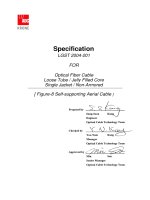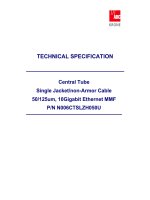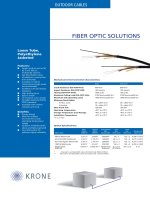Datasheet - FO - Cable - Non-Armor FIGURE 8
Bạn đang xem bản rút gọn của tài liệu. Xem và tải ngay bản đầy đủ của tài liệu tại đây (212.5 KB, 9 trang )
Specification
LGST 2004-201
FOR
Optical Fiber Cable
Loose Tube / Jelly Filled Core
Single Jacket / Non-Armored
[ Figure-8 Self-supporting Aerial Cable
]
1. SCOPE
1.1 Application
This specification covers the general requirements for fiber optic telecommunication
cables used for self-supported aerial applications.
1.2 Cable Description
Color coded fibers, filled color coded loose tubes, PE filler, SZ-stranding around the
dielectric central strength member, flooding jelly compound, core wrapping tape, ripcords,
messenger wires and outer PE jacket.
2. OPTICAL FIBER
The optical, geometrical and mechanical performance of the optical fiber shall be in
accordance with Table 1 and 2 below.
Table 1. The Optical, Geometrical and Mechanical Performance of the Multi Mode Fiber
SPECIFICATION
ITEMS UNITS
50 Multi Mode 62.5 Multi Mode
Attenuation dB/km
≤ 3.0 at 850nm
≤ 1.0 at 1300nm
≤ 3.5 at 850nm
≤ 1.0 at 1300nm
Bandwidth MHz.km
≥ 400 at 850nm
≥ 600 at 1300nm
≥ 200 at 850nm
≥ 400 at 1300nm
Numerical Aperture -
0.20±0.015 0.275±0.015
Core Diameter
μm 50±3.0 62.5±3.0
Core Non-circularity %
≤ 6.0 ≤ 6.0
Cladding Diameter
μm 125±2.0 125±2.0
Cladding Non-circularity %
≤ 2.0 ≤ 2.0
Core/Cladding
Concentricity Error
μm ≤ 3.0 ≤ 3.0
Coating Diameter
μm 245±15 245±15
Proof Test kPsi
≥ 100 ≥ 100
* Other performance value available upon request.
Table 2. The Optical and Geometrical Performance of Single Mode Fiber (ITU-T G652)
ITEMS UNITS SPECIFICATION
Attenuation dB/km
≤ 0.36 at 1310nm
≤ 0.22 at 1550nm
Attenuation vs. Wavelength dB/km
≤ 0.05 at 1285nm & 1330nm
(from the 1310nm value)
≤ 0.05 at 1525nm & 1575nm
(from the 1550nm value)
Point Discontinuity dB
≤ 0.10 at 1310nm & 1550nm
Attenuation at Water peak dB/km
≤ 1.5 at 1383nm
Chromatic Dispersion ps/nm.km
≤ 3.5 at 1285 nm ~ 1330 nm
≤ 18 at 1550 nm
Cable Cut-off Wavelength (λcc)
nm
≤ 1260
Zero Dispersion Slope ps/nm
2
.km
≤ 0.093
Polarization Mode Dispersion
ps/√km ≤ 0.5
Attenuation vs. Bending
75mm x 100turns
dB
≤ 0.05 at 1550nm
≤ 0.10 at 1550nm
Mode Field Diameter
μm
9.3 ± 0.5 at 1310nm
10.5 ± 1.0 at 1550nm
Mode field Concentricity error
μm ≤ 0.8
Cladding Diameter
μm 125 ± 1.0
Cladding Non-circularity %
≤ 1
Coating Diameter
μm 245 ± 10
Proof Test GN/m
2
≥ 0.7
3. CABLE CONSTRUCTION
The construction of the cable shall be in accordance with Table 3 below.
Table 3. Construction of the Cable
ITEMS DESCRIPTION
Number of Fibers Max. 72
No. of Fibers per Tube 6 or 12
Loose Buffer Tube PBT (Polybutylene Terephthalate)
Filling Compound
in Loose Buffer Tube
Thixotropic Jelly Compound
Filler
Polyethylene Rod
(if necessary to make good core configuration)
Central Strength Member FRP
Flooding Compound
between Loose Tubes
Polybutene Jelly Compound
Core Wrapping Tape
Plastic Tape
(To provide heat barrier and good core configuration)
Rip Cord
Two ripcords
(To provide easy cable entry, approx. 180° separation)
Material 7-strands of Galvanized Steel Wire
Messenger
Wire
Diameter Nom. 2.0mm (each strand)
Material Black MDPE or HDPE
Outer Jacket
Thickness Nom. 1.8mm
4. FIBER AND LOOSE BUFFER TUBE IDENTIFICATION
The color code of the loose buffer tubes and the individual fibers within each loose buffer
tube shall be in accordance with Table 4 below.
Table 4. The Color Code of the Individual Fibers and Loose Tubes
No. Color No. Color
1 Blue 7 Red
2 Orange 8 Black
3 Green 9 Yellow
4 Brown 10 Violet
5 Slate 11 Rose
6 White 12 Aqua
5. PHYSICAL / MECHANICAL / ENVIRONMENTAL
PERFORMANCE AND TESTS
5.1 Temperature Range
For the cables covered by this specification, the following temperature ranges apply:
-. Operation : -25 °C to +70°C
-. Installation : -10 °C to +60°C
-. Storage/Shipping : -40 °C to +70°C
5.2 Typical Span, Sag and Tension
NESC loading condition, recommended span, sag and tension for Figure-8 type aerial
cable is described in Table 5 and 6 below.
Table 5. Recommended Span, Sag and Tension
Every Day Operation
NESC Loading (Light)
Fiber
Counts
Span
(m)
Normal Sag
(m )
Tension
(kg)
Max. Sag
(m)
Max. Tension
(kg)
6 ~ 36 50 0.5 197 0.80 345
48 ~ 72 50 0.5 200 0.81 350
Table 6. Environmental Conditions in NESC
Loading Districts (NESC, Rule 250B)
Items Unit
Light Medium Heavy
Installation 20 20 20
Every Day Operation 15 15 15
Temperature
Max. Operation
°C
-1 -10 -20
Ice Thickness mm - 6.5 12.5
Wind Speed km/hr 123.2 82.1 82.1
Wind Pressure kg/m
2
43.9 19.4 19.4
5.3 Mechanical and Environmental Performance of the Cable
The mechanical and environmental performance of the cable shall be in accordance with
Table 7 below. Unless otherwise specified, all attenuation measurements required in this
section shall be performed at 1550nm for single mode fiber (SM) and at 1300nm for multi
mode fiber (MM) and monitored before and after of each test items in Table 7.
The messenger wire part may be removed from the cable sample for convenience in
testing, but for tensile strength test, it shall not be removed from the sample.









